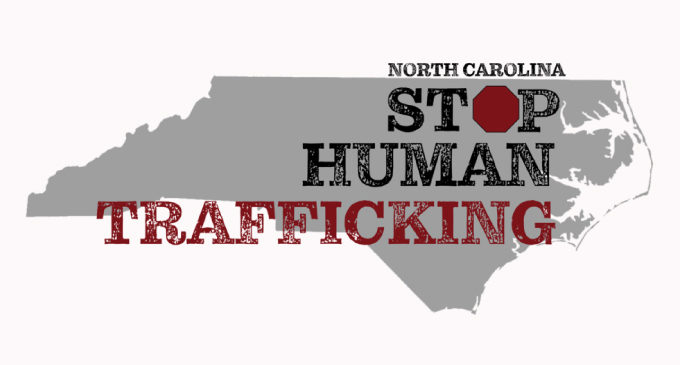Trafficking is a misunderstood crime: 3 facts you should know

By Ashley Garris
More people are enslaved today than at any point in human history. Even the U.S. is haunted by this underground human rights violation. In 2018 alone, 23,078 survivors of human trafficking had their cases reported to the National Trafficking Hotline – a staggering number, but one that likely doesn’t fully capture the true extent of the crime.
Often when people think of human trafficking, they imagine plotlines from movies like “Taken” or “Rambo.” But the reality is rarely as Hollywood depicts it. My work with World Relief Triad has opened my eyes to what human trafficking really looks like and dispelled many misconceptions I had when I started the job. I’ve shared some of them below and hope that they empower my fellow North Carolinians to join in the fight to make our state a safe and free place for all.
Myth #1: All trafficking victims are female.
Because the movies and media often focus on sex trafficking incidents, they tend to depict only young female victims – often middle-class teenagers from happy families and nice neighborhoods. But while many victims are female, not all of them are. Men can be coerced into sex trafficking as well, and both sexes can be coerced into labor trafficking. The Polaris Project reports that of the 23,078 survivors who contacted the National Trafficking Hotline in 2018, 15,042 were female, 2,917 were male, 109 were gender minorities. (The sex of the remaining 5,010 is unknown).
At World Relief Triad, half of the survivors we assist are women and half are men. Some of them have fled labor trafficking, some sex trafficking and some both. But none of them has a story that remotely resembles a Hollywood movie, and all of them possess extraordinary courage and hope. The more we can dismantle unhelpful stereotypes, the better we’ll be able to help those who are trapped to find freedom and healing.
Myth #2: Traffickers kidnap their victims, often using force.
Traffickers are a lot smarter than the media would lead you to believe. They rarely target and kidnap total strangers. Instead, they carefully select victims from unstable backgrounds, such as foster care or runaways, and groom them over a long period of time until they’ve built a sense of trust and care. Then, they turn on their victims and exploit them, leaving these vulnerable individuals totally blindsided and traumatized.
Take John*, one of the survivors we’ve worked with. He met Zack* at a party and the two quickly struck up a friendship. Zack told John about an opportunity to work at a carnival out of state. It sounded simple enough: They’d set up the show and machinery, explore a town and party, and then move on to another city, with John taking one shift and Zack taking the other. It sounded like a fun opportunity, so John took it.
It wound up being a typical bait-and-switch scenario: John would work the 16-hour shifts alone and Zack would pick him up at the beginning and end of each shift, so John had no way of escape. When time passed and John hadn’t gotten paid, he asked Zack what was going on, and the latter responded: “You work for me now.”
The situation escalated. If John went to the bathroom, Zack would text him about getting back to work. Eventually, Zack became physically violent toward John when he hesitated to hand over the money he made during his shift that day. It wasn’t until World Relief service providers intervened that John recognized his situation for what it was and was able to get out. Kidnapping wasn’t the issue here and carrying pepper spray wouldn’t have helped him recognize a trafficker in someone who seemed like a friend. This simplistic advice ignores the complex and manipulative situations many human trafficking victims find themselves caught in.
Myth #3: Sex trafficking isn’t the only form of trafficking.
As John’s story shows, sex trafficking isn’t the only kind of trafficking. Many industries – including the carnival business – thrive off the backs of victims forced to work against their will. Trafficking incidents often occur in domestic labor like nannying and housekeeping, traveling sales teams, or construction or landscaping companies.
In North Carolina, labor exploitation frequently occurs in the agricultural industry. Last year, a story broke about several workers from Mexico who had been hired to work temporary agricultural jobs in our state on the H-2A visa. The men had been promised generous pay and the chance to extend their stay.
Upon arrival, however, they had their Social Security cards stolen, were given substandard housing to live in, had their wages denied them, and were repeatedly threatened by their employer. They successfully sued for labor trafficking and were awarded $75,000 in a settlement – a happy ending to an otherwise horrifying story of human rights violation and injustice.
I share these stories not to alarm or frighten, but to equip men and women across our state to spot the signs of human trafficking in all of its forms. The more we understand about how this industry works and who it tends to exploit, the better we’ll be able to spot victims and pass this information on to law enforcement and other agencies like World Relief Triad that work to end trafficking. This is the first step to helping victims regain hope and rebuild their lives.
*Zack and John’s names have been changed to preserve confidentiality.
Ashley Garris is an Anti-Human Trafficking Client Coordinator with World Relief Triad.










